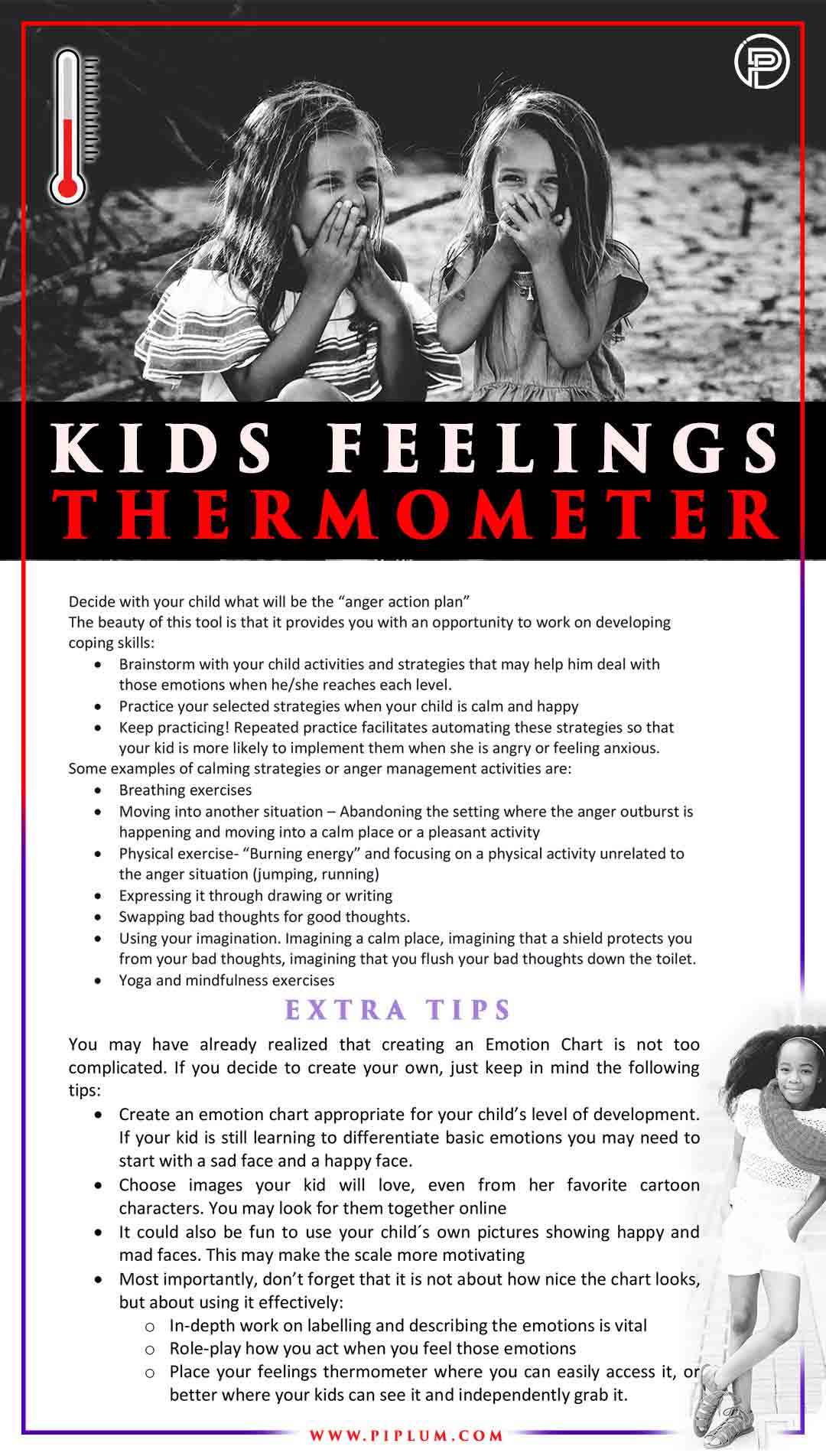
Helping a child learn to vent and manage their emotions is essential for their emotional development and well-being. One effective tool to achieve this is the “Kids’ Feelings Thermometer.” The goal is to teach children to identify and express their emotions appropriately. Here are some exercises to help a child vent emotions using the Kids’ Feelings Thermometer:
- Create the Feelings Thermometer: Draw a simple thermometer with different levels or color codes representing various emotions. For example:
- Level 1 (Calm): Happy, calm, relaxed.
- Level 2 (Mild): Excited, content, curious.
- Level 3 (Moderate): Anxious, frustrated, worried.
- Level 4 (Intense): Angry, upset, scared.
- Level 5 (Extreme): Overwhelmed, furious, terrified.
- Identify Emotions: Teach the child the emotions associated with each level on the thermometer. Use age-appropriate language and examples to help them understand the feelings.
- Practice Mindful Breathing: Teach the child deep breathing techniques. When they find themselves at higher levels of the thermometer, encourage them to take slow, deep breaths to calm down.
- Draw and Express: Provide the child with drawing materials and ask them to draw what they are feeling when they experience different emotions. This helps them externalize their emotions.
- Use Feelings Journal: Create a feelings journal where the child can write or draw about their emotions each day. This helps them process and understand their feelings better.
- Role-playing: Act out scenarios where the child faces different emotions, and guide them to respond appropriately. Encourage open communication about their feelings during the role-playing.
- Safe Space for Expression: Designate a specific area in the house where the child can go to express their emotions freely without judgment. It can be their bedroom or a cozy corner with some soft toys.
- Emotion Charades: Play emotion charades where the child can act out different feelings, and others guess the emotion they are portraying.
- Read Books on Emotions: Use storybooks that focus on emotions and discuss the characters’ feelings and reactions.
- Encourage Verbal Expression: Always encourage the child to express their feelings verbally. Listen attentively and validate their emotions, even if you don’t necessarily agree with their perspective.
- Practice Empathy: Teach the child to empathize with others’ emotions, which can help them relate better to their own feelings and those of their peers.
Remember, it’s essential to create a safe and supportive environment for the child to express themselves. Encourage open conversations about emotions and celebrate their progress in managing their feelings effectively. Each child is unique, so adapt these exercises to suit their age, personality, and emotional needs.
You might like: Moms! Ask These Questions to Foster a Deeper Connection With Your Kids
Kids Feelings Thermometer
Let’s begin with a quote:
Family Is Not An Important Thing. It’s Everything. Inspirational Quote by Michael J. Fox.
For a child, emotions are like an uncontrollable element, which he neither understands nor can control. But how can we help a child know emotions? In what ways can we help a child calm down when emotions overwhelm? And what methods can we use to help a child learn to express emotions and make friends with them not spontaneously but properly?
Pour out emotions while drawing
Children quite often like and find it valuable if we offer to draw that anger as something.
If a child’s anger, sadness, frustration, jealousy, or other feelings were like anything or animal, what would that thing or animal be? From this, we can also see how the child feels in these feelings. Children often draw that fear is like a hare or a bunny; anger is like a devil and the like. So based on that, we can feel how the child feels.
This method is also suitable when the child does not know how they are feeling. In such cases, we can ask what kind of animal the child feels like. Based on this, we can learn more about how the child feels. When a child draws their feeling, we can offer him several options. If this feeling is very unpleasant and the child wants it to end as soon as possible, we can offer to draw it, wrinkle the drawing, and throw it away.
We can also offer to draw a feeling and talk to it (suitable for slightly more mature children).
Kids Feelings Thermometer. Help Children To Control Emotions:

For example, thank you, anger, which you are like a wolf for keeping me safe so that nothing bad happens, but I’m already fine, so you can leave me and leave. Again, we can help or throw the drawing somewhere. Another way to draw a feeling that a child no longer wants and that bothers is to offer to close that object to prison. Think of what a prison is, “close” that feeling and conclude that you are already safe from that feeling, and it can no longer reach you.
You might like this article: Moms! Ask Your Kids These Questions! Help Kids Know Themselves Better.
Write down all emotions
Also, for children who already know how to write at least to some extent (or who imagine writing, even though they don’t write correctly yet), we can offer to write and thus vent all of their emotions.
Write it down with all the words, all the epithets, with everything the child wants. The point of all this is for the child’s feelings to move on the sheet.
Let the child write it all down, but we should teach that these words should and remain on this sheet. The other person should not see or hear it because it is painful and rude. Once those words have been spelled out, we can offer the child to tear or postpone that text somewhere, but it is best to be discarded. It’s like throwing a feeling out of yourself. Not pouring out a feeling to another person, not “exploding”, but throwing out.
If the child is already able to communicate their feeling a little more mature, we can suggest writing a letter to the father or mother about how the child feels while it is still difficult to talk about it.
You might like: What Kind of Oil is Best for Children: The doctors Offer a Few Alternatives
In the letter, the child could write down what is on his mind, but in a little more polite, decent words, so that it is not just a “pouring out” of emotion.
Parents who receive such a letter can then better listen to how the child feels, not react so emotionally because there is no child nearby, and thus can more easily help the child cope with his feelings.
You might like: How Gut Bacteria Affects The Brain And Body. [infographic]
So this method of writing is basically really valuable for adults as well when we feel a lot of tension, and we need to help it somewhere, “Throw it away.”
Pour emotions on a friend.
The last of suggestions (although there may be many more) is to offer the child to draw a friend and talk to him
This will help the child to vent emotions, talk, and it may be bolder and more comfortable for the child than talking to an adult at the time.
For example, a child may go and wholeheartedly complain to his friend about a teddy bear or a car, which is already easier for him.
We wish everyone success in this seemingly tricky but exciting path because we can grow up with children, get to know them, and discover really many interesting things.
Related inspirational quotes qoutes:
